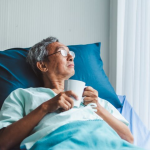Breakthroughs in Addressing Social Determinants of Health
A growing number of physicians are not only asking their patients, “what’s wrong,” but “what’s happening?”
This new awareness of the impact of life outside the exam room in determining health care status is fostered by the growing number of studies and discussion around social determinants of health (SDOH). Social determinants of health are the conditions in the environments in which people are born, live, learn, and work that affect a wide range of health and quality-of-life outcomes. While SDOHs are traditionally outside of the health system, they impact individual and population health.
A recent study by the Permanente Medical Groups found that one-third of Americans are stressed to meet basic needs such as stable housing, adequate food, and reliable transportation. More than one in four cites an unmet social need as a barrier to health. Twenty-one percent prioritize paying for food or rent over seeing a doctor or getting a medication. Overwhelmingly, physician leaders are stepping up to help patients meet these conflicting needs.
Systems and Social Determinants of Health
Closing the gaps in health care related to social determinants demands the ability to do four tasks:
- Identify the patient’s needs
- Find the right resources to meet those needs
- Make the connection to access the necessary resources
- Ensure that the intervention occurred
Integrating these functions into the health care delivery system requires both a team approach between health care providers and community resources and the technological connection to automate communications and track what has happened.
Physicians are in a pivotal position to identify factors outside the health care facilities that affect patient health. With connected and robust information technology, leaders of multispecialty groups, such as those in the Council of Accountable Physician Practices, are developing innovative processes to bring in the resources to close health gaps that result from SDOH. Existing tools such as digital technology, interoperable electronic medical records, and screening questions programmed into the medical record make these connections quickly and automatically.
Helping Patients with Diabetes Eat Healthy
Food insecurity, or lack of consistent access to nutritious food, affects one in eight adults in America. At Geisinger, a CAPP health care system based in Central Pennsylvania, using food as medicine has made a big difference in the lives and health of their patients.
Since 2016, Geisinger’s Fresh Food Pharmacy has educated and provided diabetes patients with fresh and nutritious food. Their goal is to “deliver the gold standard of diabetes care by providing diabetes education and healthy food in a sensitive, caring and respectful manner.”
Patients with diabetes or pre-diabetes and who have been identified as “food insecure” receive a Fresh Food prescription. Following this prescription, patients receive 20 hours of education with health coaches about diabetes, and a kitchen kit with measuring cups, recipes, and nutrition information. Each week, the pharmacy provides the patient and their family with ingredients for 10 balanced meals.
The education doesn’t stop there. Each patient joins a weekly diabetes self-management support group and accesses digital nutritional content.
Through the Fresh Food Pharmacy program, patients can manage their diabetes with fewer complications; and some individuals have been able to reduce their medications. In addition to improved health, the program is also saving money. Due to the proactive and preventive measures that were put in place, over the first 18 months, there was an 80% decrease in costs for enrolled patients, or $48,000 in savings per patient per year.
Oregon Patients Automatically Connected to Food Banks for Healthy Eating
At the Northwest Permanente Medical Group in Oregon, a new program called “Thrive Local” enables physicians to seamlessly connect patients to geomapped community-based organizations for support. For example, if a patient cannot afford or access food, the physician can note this situation in the patient’s electronic health record at the time of the exam or office visit. This action automatically alerts the food banks closest to the patient’s home. After one organization has completed the delivery, the program indicates to the other two that the need has been met. The result: the patient quickly receives the food, and there’s no follow-up needed by the physician or staff.
A recent Thrive Local pilot resulted in more than 18,000 referrals for nearly 8,000 patients to 6,500 community-based organizations. Participating organizations include medical support needs and access to transportation, utilities, housing, and food. Soon, the program will be rolled out across all Kaiser Permanente medical groups.
Raising Healthy Children and Avoiding Adverse Childhood Events
At Atrius Health in Massachusetts, pediatricians take whole family health seriously. They feel responsible for not only taking care of their young patients, but also to nurture the healthy adults of the future.
Hunger, instability in the home, homelessness, and inadequate nurturing are just some of the situations identified as “adverse childhood events” that can lead to a lifetime of poor health and other problems. Atrius’ pediatricians developed a system to identify and meet families’ needs outside the exam room.
At each annual pediatrics exam, a parent or caregiver completes an annual social determinants of health (SDOH) questionnaire. Reminders in the electronic medical record ensure that everyone fills out this questionnaire and no one falls through the cracks. The nine-question survey identifies individuals and families’ potential concerns about permanent housing, employment, ability to pay utilities, as well as access to food, transportation, childcare, and mental health resources. While the questionnaire takes less than five minutes to complete, its results are invaluable for physicians, who now receive the information they need to help eliminate barriers to health care.
If the questionnaire indicates that the child or family may have issues in any of these areas, a provider will begin a conversation about these situations and connect them with a facilitator to pair them with community resources.
Atrius also adapts its clinic operations to help meet patients’ needs, such as combining multiple appointments into one visit, arranging transportation to medical visits, and helping families obtain SNAP benefits (food stamps).
Providing Health Care, Not Just Sick Care, Means Treating the Whole Patient
These stories are just three examples of how organized and accountable physician-led medical groups treat the whole patient, not just the symptoms that present in the exam room. Health care for life is an investment that requires a care delivery system that is connected through technology, organized into care teams, and dedicated to meeting the patient where they are. This is the definition of true population health: managing everything that influences a patient’s wellbeing so that they achieve their full potential for health. It is this systematic approach that should be incentivized by payment models that reward outcomes – not just medical service delivery.





